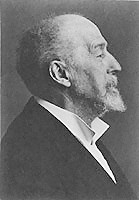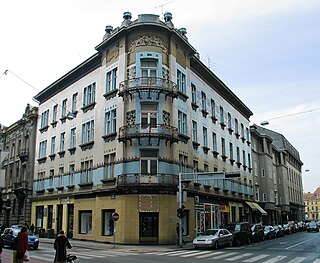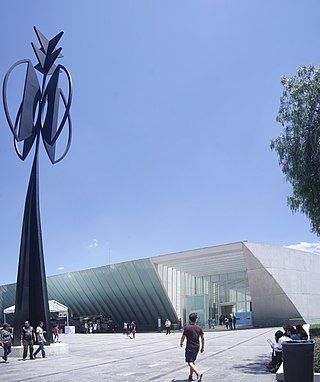
Art Nouveau is an international style of art, architecture, and applied art, especially the decorative arts. It was often inspired by natural forms such as the sinuous curves of plants and flowers. Other characteristics of Art Nouveau were a sense of dynamism and movement, often given by asymmetry or whiplash lines, and the use of modern materials, particularly iron, glass, ceramics and later concrete, to create unusual forms and larger open spaces. It was popular between 1890 and 1910 during the Belle Époque period, and was a reaction against the academicism, eclecticism and historicism of 19th century architecture and decorative art.

Francisco "Pancho" Villa was a general in the Mexican Revolution. He was a key figure in the revolutionary movement that forced out President Porfirio Díaz and brought Francisco I. Madero to power in 1911. When Madero was ousted by a coup led by General Victoriano Huerta in February 1913, he joined the anti-Huerta forces in the Constitutionalist Army led by Venustiano Carranza. After the defeat and exile of Huerta in July 1914, Villa broke with Carranza. Villa dominated the meeting of revolutionary generals that excluded Carranza and helped create a coalition government. Emiliano Zapata and Villa became formal allies in this period. Like Zapata, Villa was strongly in favor of land reform, but did not implement it when he had power. At the height of his power and popularity in late 1914 and early 1915, the U.S. considered recognizing Villa as Mexico's legitimate authority.

The city of Chihuahua or Chihuahua City is the state capital of the Mexican state of Chihuahua. As of 2020, the city of Chihuahua had a population of 925,762 inhabitants. while the metropolitan area had a population of 988,065 inhabitants.

Hector Guimard was a French architect and designer, and a prominent figure of the Art Nouveau style. He achieved early fame with his design for the Castel Beranger, the first Art Nouveau apartment building in Paris, which was selected in an 1899 competition as one of the best new building facades in the city. He is best known for the glass and iron edicules or canopies, with ornamental Art Nouveau curves, which he designed to cover the entrances of the first stations of the Paris Metro.

La Plata is the capital city of Buenos Aires Province, Argentina. According to the 2022 census, the Partido has a population of 772,618 and its metropolitan area, the Greater La Plata, has 938,287 inhabitants. It is located 9 kilometers inland from the southern shore of the Río de la Plata estuary.

Otto Koloman Wagner was an Austrian architect, furniture designer and urban planner. He was a leading member of the Vienna Secession movement of architecture, founded in 1897, and the broader Art Nouveau movement. Many of his works are found in his native city of Vienna, and illustrate the rapid evolution of architecture during the period. His early works were inspired by classical architecture. By mid-1890s, he had already designed several buildings in what became known as the Vienna Secession style. Beginning in 1898, with his designs of Vienna Metro stations, his style became floral and Art Nouveau, with decoration by Koloman Moser. His later works, 1906 until his death in 1918, had geometric forms and minimal ornament, clearly expressing their function. They are considered predecessors to modern architecture.

The Francisco Villa Museum is dedicated to the life and times of the Mexican Revolutionary, Francisco "Pancho" Villa. The museum is in Chihuahua, Chihuahua, Mexico, and is housed in the former estate of General Francisco Villa and his widow, María Luz Corral de Villa.

Ciudad Universitaria is the main campus of the National Autonomous University of Mexico (UNAM), located in Coyoacán borough in the southern part of Mexico City. Designed by architects Mario Pani and Enrique del Moral, it encloses the Olympic Stadium, about 40 faculties and institutes, the Cultural Center, an ecological reserve, the Central Library, and a few museums. It was built during the 1950s on an ancient solidified lava bed in Coyoacán called "El Pedregal" to replace the scattered buildings in downtown Mexico City where classes were given. It was completed in 1954 at a cost of approximately $25 million. At the time of its completion it was the largest single construction project in Mexico since the Aztecs. It was declared a World Heritage Site by UNESCO in 2007.

Casa Chihuahua Centro de Patrimonio Cultural, once known as the Federal Palace of Chihuahua, is an early 20th-century building in the city centre of Chihuahua, Chih., Mexico. It served as the federal building for the city until 2004, when it was renovated as a city museum, specialising in travelling exhibits. It also houses, in the basement, the jail cell of father Miguel Hidalgo y Costilla, considered the Father of the Nation. Father Hidalgo was the first leader of the insurgency for independence from Spain. He was captured by the Spaniards early in 1811, tried and executed on 30 July 1811 at the neighbouring Government Palace. His jail cell is a national shrine.

The Museo de la Lealtad Republicana, also known as the Museo Casa Juárez, is a 19th-century building in the city centre of Chihuahua, Mexico. It housed the constitutional government of President Benito Juárez during his stay in Chihuahua while Maximilian of Habsburg reigned as Emperor of Mexico, supported by the French, and was thus the de facto National Palace of Mexico.

Casa Wiechers-Villaronga is a Classical Revival style mansion in Ponce, Puerto Rico designed and built in the early twentieth century. The house was acquired and restored by the Institute of Puerto Rican Culture and now operates as the Museo de la Arquitectura Ponceña. The house sits in the Ponce Historic Zone. The Villaronga Residence is an outstanding example of the Classical Revival style in used in Ponce designs in the early part of the 20th century and is one of two residences still standing of a series of houses designed and built by Alfredo B. Wiechers, so important to the architectural and cultural heritage of the city of Ponce.

The Kallina House is a historic residential building in Zagreb, Croatia. The house is located in the city centre on the corner of Masarykova and Gundulićeva streets and is regarded as "one of the finest examples of Secessionist-style street architecture in Zagreb."

The Villa Majorelle is a house located at 1 rue Louis-Majorielle in the city of Nancy, France, which was the home and studio of the furniture designer Louis Majorelle. It was designed and built by the architect Henri Sauvage in 1901-1902. The villa is one of the first and most influential examples of the Art Nouveau architectural style in France. It served as a showcase for Majorelle's furniture and the work of other noted decorative artists of the period, including ceramist Alexandre Bigot and stained glass artist Jacques Gruber. It is now owned by the city of Nancy, and is open to the public certain days for tours by reservation.

The Museo de la Arquitectura Ponceña is an architecture museum housed at the Casa Wiechers-Villaronga, in Ponce, Puerto Rico. It is preserves the history of the architectural styles of Ponce and Puerto Rico. The Casa Wiechers-Villaronga was acquired and restored by the Institute of Puerto Rican Culture. The museum is located in the Ponce Historic Zone. The historic house was designed and built in 1912 by Alfredo B. Wiechers. The house that is home to this architecture museum is itself an example of the architectural history of the city. The museum is housed at the historic Casa Wiechers-Villaronga.
Chihuahua's historic downtown is one of the most important business districts of the city. The downtown is home to a shopping hub called Libertad Street, and contains most of the historical landmarks of the capital city, including the Cathedral of Chihuahua, Museo Casa Chihuahua, Museo Casa Juarez and the celebrated Quinta Gameros, one of the finest examples of early 20th century architecture in the whole state of Chihuahua.
The following is a timeline of the history of the city of Chihuahua, Mexico.

The Museo Universitario Arte Contemporáneo, also known as MUAC, is a large contemporary art museum located within the main campus of the National Autonomous University of Mexico (UNAM). It opened in November 2008 and it is the first Mexican public museum exclusively focused to the arts created in the XXI century.

Museo de la Memoria (MUME) is a museum in Montevideo, Uruguay dedicated to the memory of those or died or were "disappeared" during the Uruguayan dictatorship of 1973 to 1985.

The Marquis of Riestra's mansion is an eclectic building with art Nouveau elements from the late 19th century located at 30 Michelena Street in Pontevedra, Spain. It currently houses the main central administrative services of the City Council of Pontevedra.



















